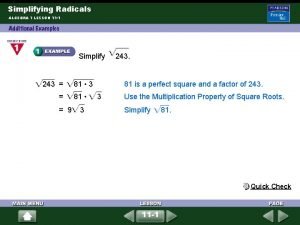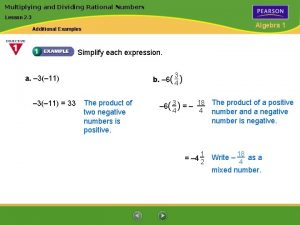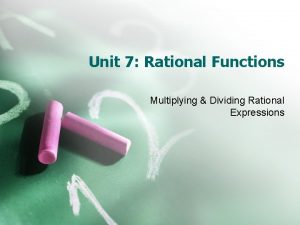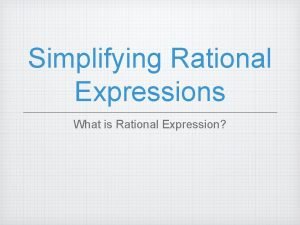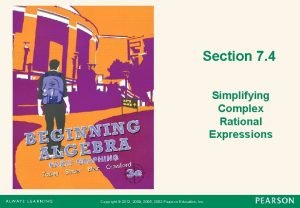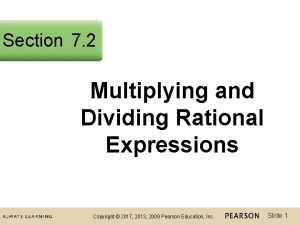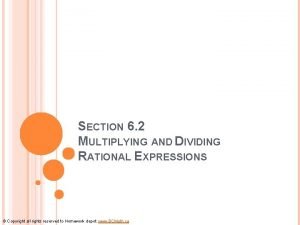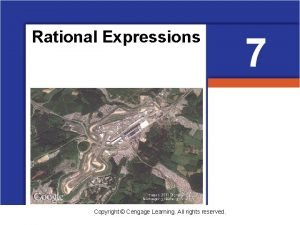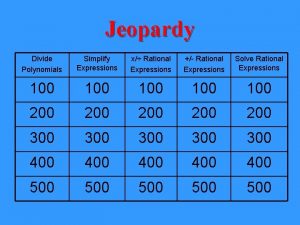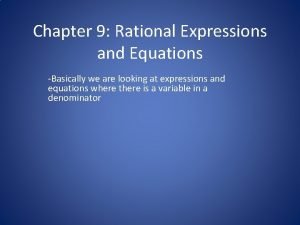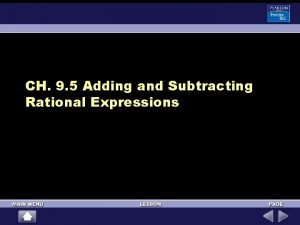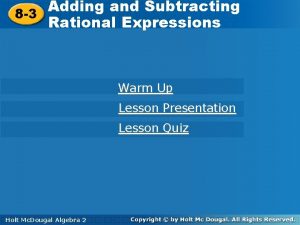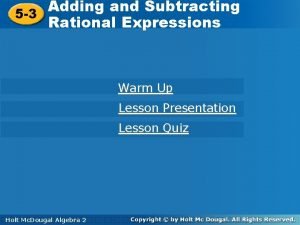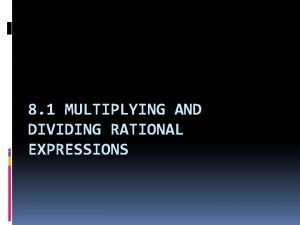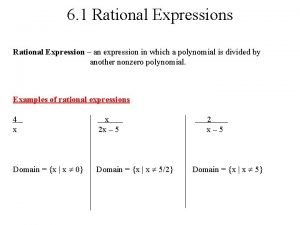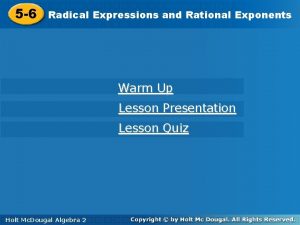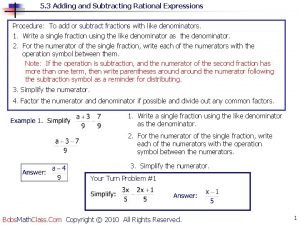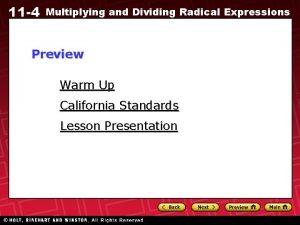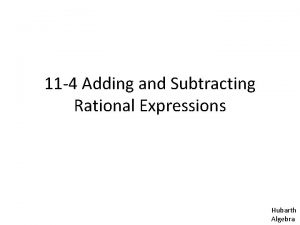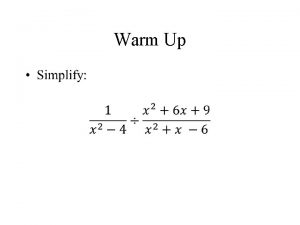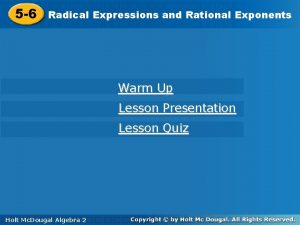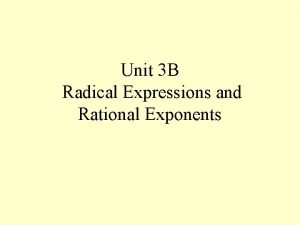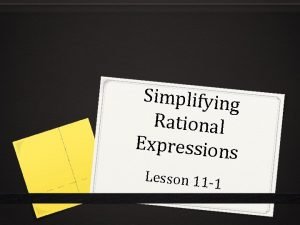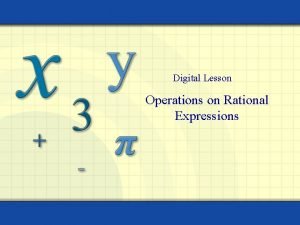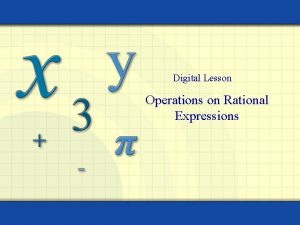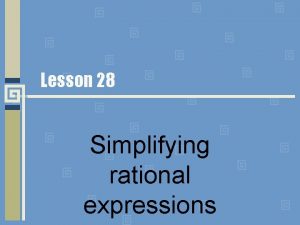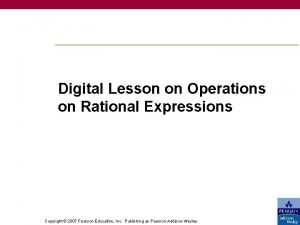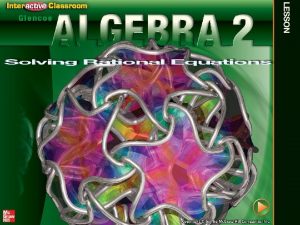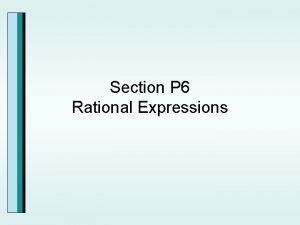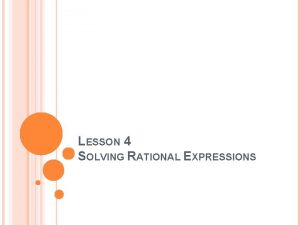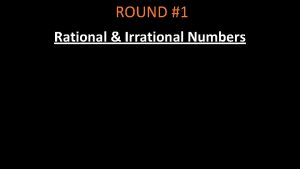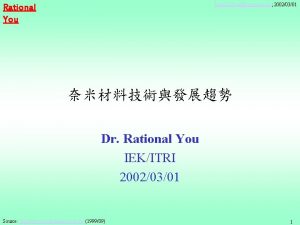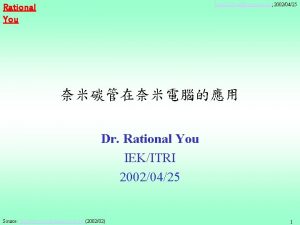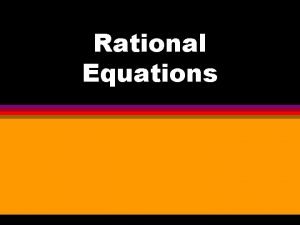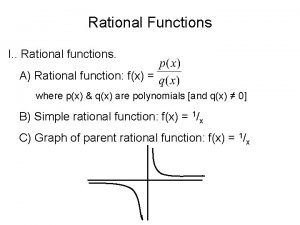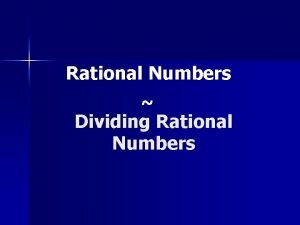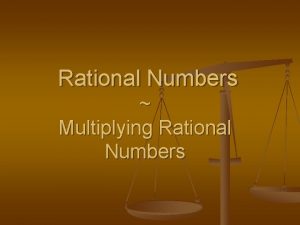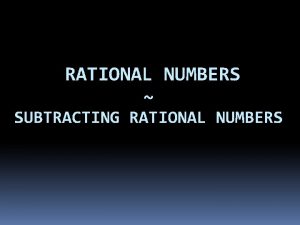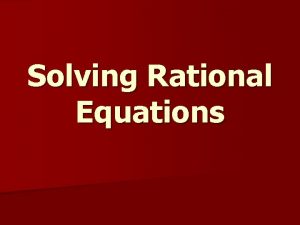Digital Lesson on Operations on Rational Expressions Copyright

























- Slides: 25

Digital Lesson on Operations on Rational Expressions Copyright © 2007 Pearson Education, Inc. Publishing as Pearson Addison-Wesley

To multiply rational expressions: 1. Write each numerator and denominator in factored form. 2. Divide out any numerator factor with any matching denominator factor. 3. Multiply numerator by numerator and denominator by denominator. 4. Simplify as needed. Example: Multiply Solution: Copyright © 2007 Pearson Education, Inc. Publishing as Pearson Addison-Wesley 2

Example Multiply. Solution Write numerators and denominators in factored form. Multiply the remaining numerator factors and denominator factors. Copyright © 2007 Pearson Education, Inc. Publishing as Pearson Addison-Wesley 3

Dividing Rational Expressions To divide rational expressions: 1. Write an equivalent multiplication statement with the reciprocal of the divisor. 2. Write each numerator and denominator in factored form. (Steps 1 and 2 are interchangeable. ) 3. Divide out any numerator factor with any matching denominator factor. 4. Multiply numerator by numerator and denominator by denominator. 5. Simplify as needed. Copyright © 2007 Pearson Education, Inc. Publishing as Pearson Addison-Wesley 4

Example Divide. Solution Write an equivalent multiplication statement. Divide out common factors, and multiply remaining factors. Copyright © 2007 Pearson Education, Inc. Publishing as Pearson Addison-Wesley 5

Adding or Subtracting Rational Expressions (Same Denominator) To add or subtract rational expressions that have the same denominator: 1. Add or subtract the numerators and keep the same denominator. 2. Simplify to lowest terms (remember to write the numerators and denominators in factored form in order to simplify). Copyright © 2007 Pearson Education, Inc. Publishing as Pearson Addison-Wesley 6

Example Add. Solution Since the rational expressions have the same denominator, we add numerators and keep the same denominator. Factor. Divide out the common factor, 2. Copyright © 2007 Pearson Education, Inc. Publishing as Pearson Addison-Wesley 7

Example Subtract. Solution Note: The numerator can be factored, so we may be able to simplify. Divide out the common factor, x – 4. Copyright © 2007 Pearson Education, Inc. Publishing as Pearson Addison-Wesley 8

Example Add. Solution Combine like terms in the numerator. Factor the numerator and the denominator. Divide out the common factor, b. Copyright © 2007 Pearson Education, Inc. Publishing as Pearson Addison-Wesley 9

Example Add. Solution Combine like terms in the numerator. Factor the numerator and the denominator. Copyright © 2007 Pearson Education, Inc. Publishing as Pearson Addison-Wesley 10

continued Divide out the common factors, 2 and x + 2. Copyright © 2007 Pearson Education, Inc. Publishing as Pearson Addison-Wesley 11

Example Subtract. Solution Note: To write an equivalent addition, change the operation symbol from a minus sign to a plus sign and change all the signs in the subtrahend (second) polynomial. Copyright © 2007 Pearson Education, Inc. Publishing as Pearson Addison-Wesley 12

Finding the LCD To find the LCD of two or more rational expressions: 1. Factor each denominator. 2. For each unique factor, compare the number of times it appears in each factorization. Write a product that includes each unique factor the greatest number of times it appears in the denominator factorizations. Copyright © 2007 Pearson Education, Inc. Publishing as Pearson Addison-Wesley 13

Example Find the LCD. Solution We first factor the denominators 12 y 2 and 8 y 3 by writing their prime factorizations. The unique factors are 2, 3, and y. To generate the LCD, include 2, 3, and y the greatest number of times each appears in any of the factorizations. Copyright © 2007 Pearson Education, Inc. Publishing as Pearson Addison-Wesley 14

continued The greatest number of times that 2 appears is three times (in 23 • y 3). The greatest number of times that 3 appears is once (in 22 • 3 • y 2). The greatest number of times that y appears is three times (in 23 • y 3). Note: We can compare exponents in the prime factorizations to create the LCD. If two factorizations have the same prime factors, we write that prime factor in the LCD with the greater of the two exponents. Copyright © 2007 Pearson Education, Inc. Publishing as Pearson Addison-Wesley 15

Example Find the LCD. Solution Factor the denominators x 2 – 25 and 2 x – 10. The unique factors are 2, (x + 5), and (x – 5). The greatest number of times that 2 appears is once. The greatest number of times that (x + 5) appears is once. The greatest number of times that (x – 5) appears is once. Copyright © 2007 Pearson Education, Inc. Publishing as Pearson Addison-Wesley 16

Adding or Subtracting Rational Expressions with Different Denominators To add or subtract rational expressions with different denominators: 1. Find the LCD. 2. Write each rational expression as an equivalent expression with the LCD. 3. Add or subtract the numerators and keep the LCD. 4. Simplify. Copyright © 2007 Pearson Education, Inc. Publishing as Pearson Addison-Wesley 17

Example Add. Solution The LCD is 24 x 2. Write equivalent rational expressions with the LCD, 24 x 2. Add numerators. Note: Remember that to add polynomials, we combine like terms. Copyright © 2007 Pearson Education, Inc. Publishing as Pearson Addison-Wesley 18

Example Add. Solution Since x – 6 and 6 – x are additive inverses, we obtain the LCD by multiplying the numerator and denominator of one of the rational expressions by – 1. We chose the second rational expression. Copyright © 2007 Pearson Education, Inc. Publishing as Pearson Addison-Wesley 19

Complex rational expression: A rational expression that contains rational expressions in the numerator or denominator. Examples: Copyright © 2007 Pearson Education, Inc. Publishing as Pearson Addison-Wesley 20

Simplifying Complex Rational Expressions To simplify a complex rational expression, use one of the following methods: Method 1 1. Simplify the numerator and denominator if needed. 2. Rewrite as a horizontal division problem. Method 2 1. Multiply the numerator and denominator of the complex rational expression by their LCD. 2. Simplify. Copyright © 2007 Pearson Education, Inc. Publishing as Pearson Addison-Wesley 21

Example—Method 1 Simplify. Solution Write the numerator fractions as equivalent fractions with their LCD, 12, and write the denominator fractions with their LCD, 24. Copyright © 2007 Pearson Education, Inc. Publishing as Pearson Addison-Wesley 22

continued 2 1 Copyright © 2007 Pearson Education, Inc. Publishing as Pearson Addison-Wesley 23

Example—Method 2 Simplify. Solution Multiply the numerator and denominator by 24. 6 1 1 3 4 1 Copyright © 2007 Pearson Education, Inc. Publishing as Pearson Addison-Wesley 24

Example Simplify. Solution Write the numerator and denominator as equivalent fractions. (Method 1) Copyright © 2007 Pearson Education, Inc. Publishing as Pearson Addison-Wesley 25
 Lesson 11-3 solving radical equations answers
Lesson 11-3 solving radical equations answers Algebra 1 examples
Algebra 1 examples Rational expressions and functions
Rational expressions and functions Site:slidetodoc.com
Site:slidetodoc.com Complex rational expressions
Complex rational expressions 11-4 practice multiplying and dividing rational expressions
11-4 practice multiplying and dividing rational expressions 6-2 multiplying and dividing radical expressions
6-2 multiplying and dividing radical expressions Reducing rational expressions to lowest terms
Reducing rational expressions to lowest terms Multiplying and dividing rational expressions quizlet
Multiplying and dividing rational expressions quizlet Simplifying expressions jeopardy
Simplifying expressions jeopardy Chapter 9 rational expressions and equations answers
Chapter 9 rational expressions and equations answers Practice 9-5 adding and subtracting rational expressions
Practice 9-5 adding and subtracting rational expressions 8-3 adding and subtracting rational expressions answer key
8-3 adding and subtracting rational expressions answer key How to add and subtract rational expressions
How to add and subtract rational expressions 8-1 multiplying and dividing rational expressions
8-1 multiplying and dividing rational expressions Expression and equation meaning
Expression and equation meaning 5-6 radical expressions and rational exponents
5-6 radical expressions and rational exponents How to add and subtract rational expressions
How to add and subtract rational expressions 11-4 multiplying and dividing rational expressions
11-4 multiplying and dividing rational expressions 11-4 practice adding and subtracting rational expressions
11-4 practice adding and subtracting rational expressions Adding and subtracting rational expressions
Adding and subtracting rational expressions 5-6 radical expressions and rational exponents
5-6 radical expressions and rational exponents Radical and rational expressions
Radical and rational expressions Solving linear rationals with lcm
Solving linear rationals with lcm How to add and subtract rational expressions
How to add and subtract rational expressions 11-6 adding and subtracting rational expressions
11-6 adding and subtracting rational expressions
